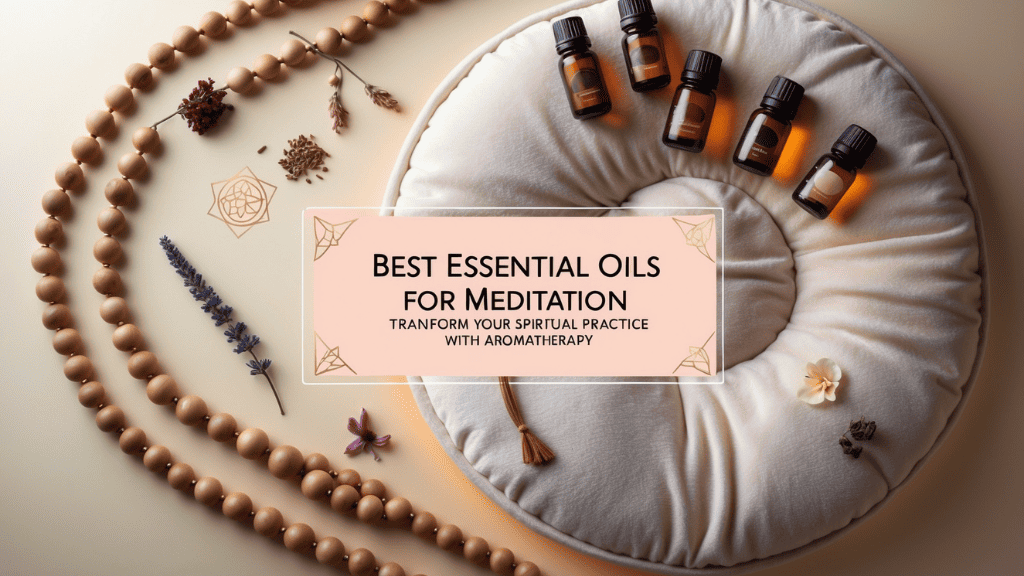
Table of Contents
Have you ever wondered how a simple scent could completely transform your meditation experience? The ancient practice of using essential oils during spiritual rituals dates back thousands of years, with cultures worldwide recognizing the powerful connection between aroma and our deepest states of consciousness!
When you create a meditation space enhanced with the right essential oils, you’re not just creating a pleasant environment—you’re activating neural pathways that can deepen your practice and elevate your spiritual connection.
The world of essential oils can seem overwhelming at first, with hundreds of options available for your spiritual practice. Each oil carries its own unique vibration and energy, capable of influencing your mental state in subtle yet profound ways. Finding the perfect aromatherapy companions for your meditation journey isn’t just about pleasant scents—it’s about discovering which oils resonate with your personal energy and spiritual goals.
Let’s explore how these botanical wonders can take your meditation experience to entirely new heights!
This post may contain affiliate links. I only recommend products and services I genuinely believe in. Additionally, some images on this website may have been created with the help of AI to convey the feeling I wish to share with the reader.
What You Might Need
- High-quality essential oil diffuser
- Selection of pure, therapeutic-grade essential oils
- Small glass bottles for creating custom blends
- Carrier oil (like jojoba or sweet almond) for dilution
- Journal to track your experiences with different oils
- Timer-equipped diffuser for meditation sessions
- Natural reed diffusers for gentle, continuous scent
Understanding the Connection Between Essential Oils and Meditation
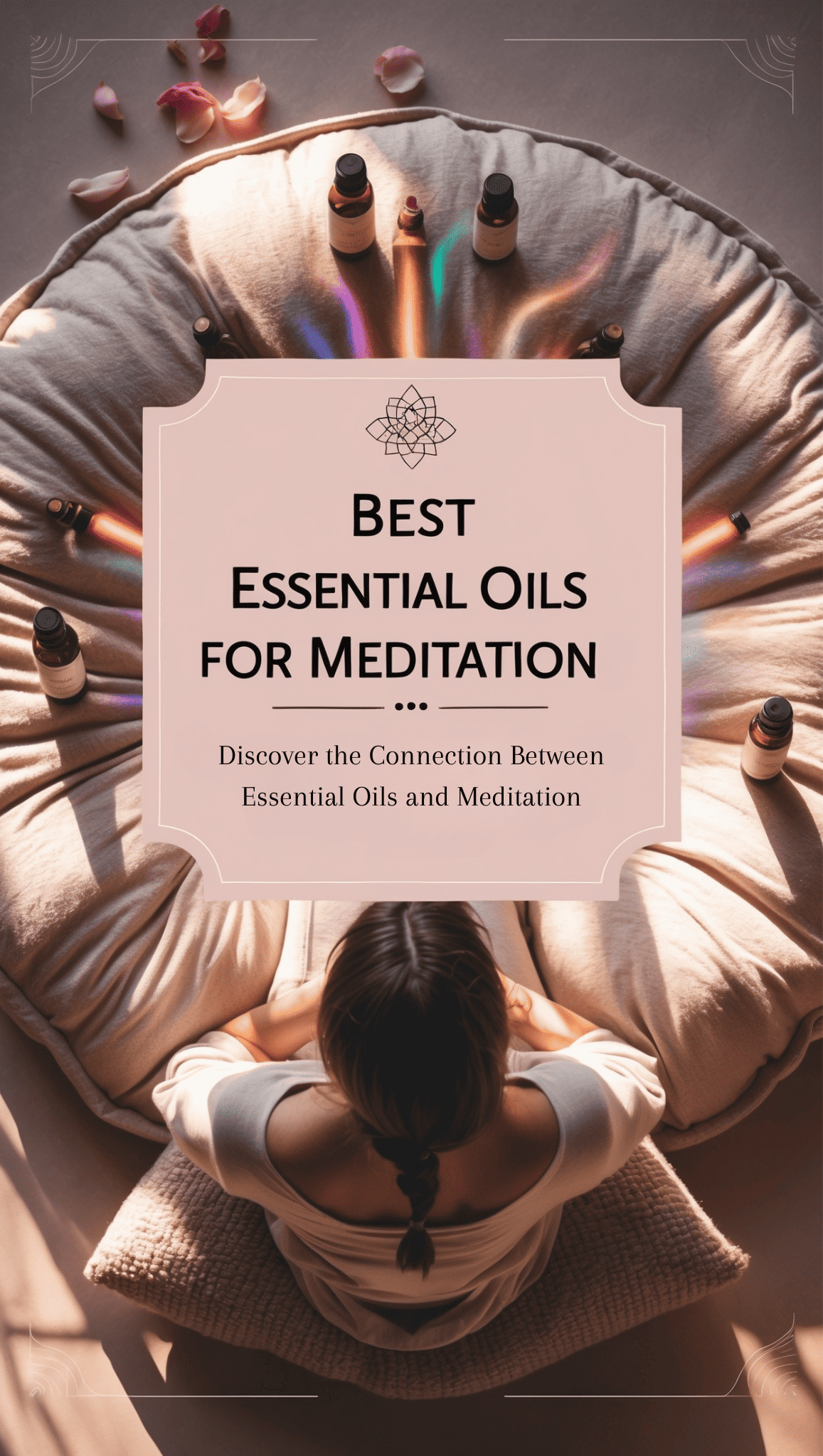
I discovered the magic of essential oils during one of the most stressful periods of my life, when my meditation practice had become stale and I struggled to quiet my mind. The first time I diffused lavender and frankincense together before sitting on my cushion, I was astonished by how quickly my thoughts settled!
There’s something deeply powerful about how these plant essences interact with our limbic system—the part of our brain that processes emotions and memories. When I incorporate aromatherapy into my spiritual practice, I notice how much easier it becomes to drop into that peaceful state where true meditation begins.
Scientists have actually documented the way certain essential oils can shift our brainwave patterns, helping us access those deeper alpha and theta states that experienced meditators reach. I’ve found this especially helpful on days when my mind feels particularly scattered or when I’m trying to establish a consistent practice.
The beauty of using aromatherapy for meditation lies in its simplicity—you don’t need elaborate equipment or years of study to benefit from these ancient plant allies. All you need is an openness to experience how these natural scents can enhance your spiritual journey in profound and unexpected ways.
The Science of Scent and Consciousness
Essential oils work directly with your olfactory system, sending signals to the limbic brain within seconds of inhalation.
Traditional Spiritual Applications
Ancient temples across cultures incorporated specific aromatic resins and oils to facilitate deeper states of prayer and meditation.
Creating Your Sacred Scent Palette
Selecting oils that personally resonate with your energy and meditation goals is more important than following general recommendations.
How to Create an Essential Oil Meditation Ritual
- Apply a single drop of diluted grounding oil like frankincense to your pulse points before practice
- Set your diffuser with your chosen blend 10 minutes before beginning meditation
- Create a specific “meditation only” blend that signals to your brain it’s time to go inward
- Incorporate a moment of mindful inhalation at the beginning of your practice
- Experiment with different scents for morning versus evening meditation sessions
How to Choose the Right Essential Oils for Your Meditation Practice
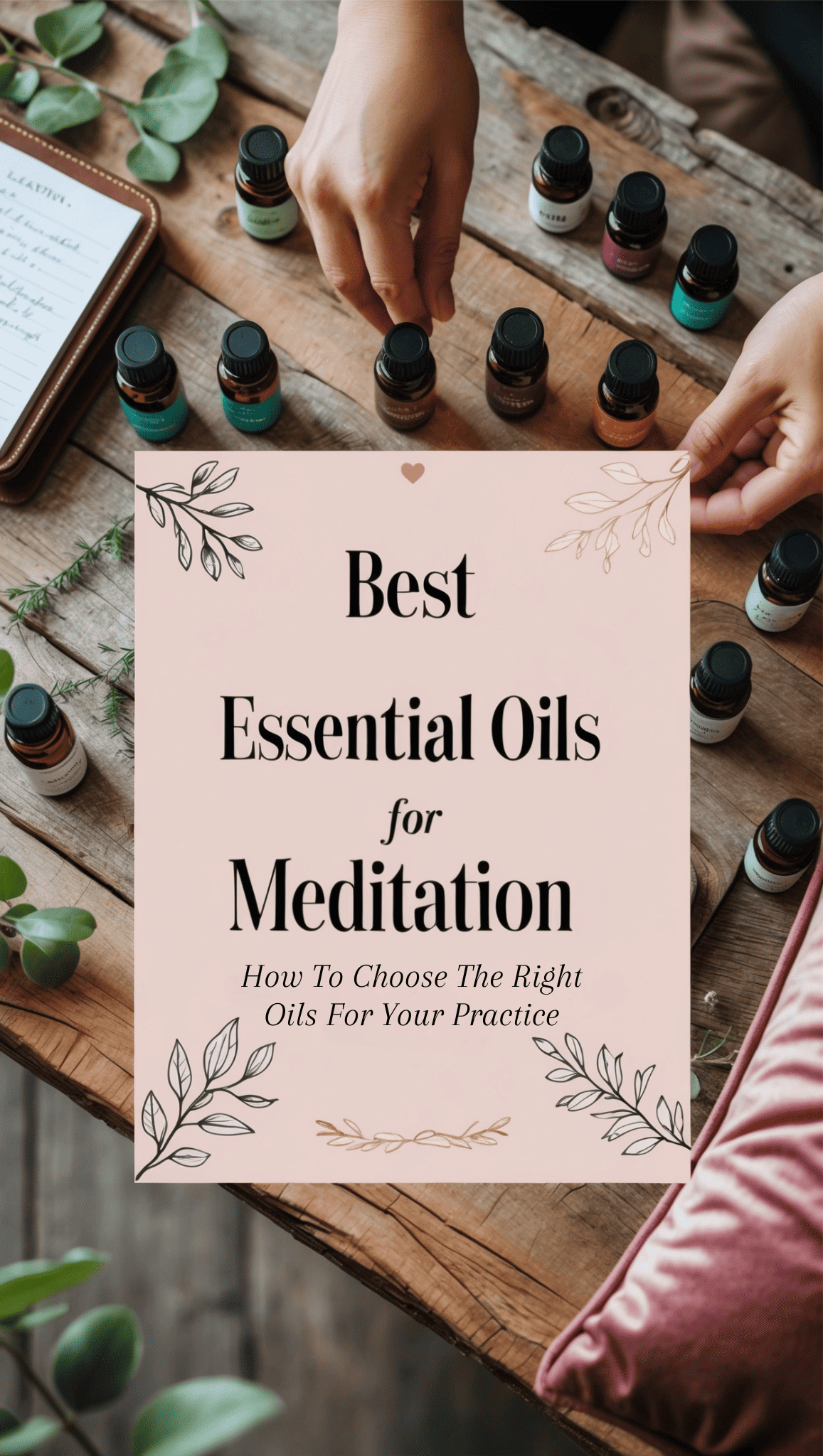
My journey with essential oils began quite haphazardly—grabbing whatever smelled nice at the health food store without understanding the subtle differences in quality or application. After experiencing headaches from synthetic fragrances masquerading as pure oils, I learned the importance of sourcing truly authentic, high-quality products for my spiritual practice! Genuine essential oils should feel alive with the plant’s energy, not overwhelming or artificial. I’ve discovered that investing in fewer, higher-quality oils creates a more profound meditation experience than having dozens of mediocre products.
When selecting oils specifically for meditation, I consider both the traditional spiritual uses and my personal resonance with the scent. Some days my spirit craves the grounding presence of cedarwood, while other times the heart-opening properties of rose call to me. Your intuition is your best guide here—notice which scents make you naturally take a deeper breath or help your shoulders relax. The oils that enhance your unique meditation journey might be completely different from what works for someone else, and that’s perfectly okay! I encourage you to approach this exploration with curiosity rather than seeking the “perfect” meditation oil.
Understanding Oil Quality and Sourcing
Look for oils that include specific botanical names and extraction methods on their labels.
Matching Oils to Meditation Goals
Choose stimulating oils like peppermint for active meditation and sedative oils like vetiver for deep relaxation practices.
Building Your Essential Oil Collection
Start with 2-3 versatile oils before expanding to more specialized scents for specific meditation purposes.
How to Evaluate Essential Oil Quality
- Check for oils with detailed sourcing information and batch numbers
- Research companies that provide third-party testing documentation
- Avoid oils with “fragrance” listed as an ingredient
- Test a small amount on paper—pure oils evaporate without leaving an oily ring
- Notice how your body responds—quality oils shouldn’t cause headaches or irritation
Picture This
You enter your meditation space as the soft glow of morning light filters through sheer curtains. The gentle mist of frankincense and lavender rises from your diffuser, creating an almost visible sacred atmosphere. As you settle onto your cushion, that first deep inhale signals to your body and mind that it’s time to journey inward. With each breath, the best essential oils for meditation support your consciousness as it gently expands beyond everyday concerns.
1. Lavender Essential Oil: The Ultimate Relaxation Enhancer
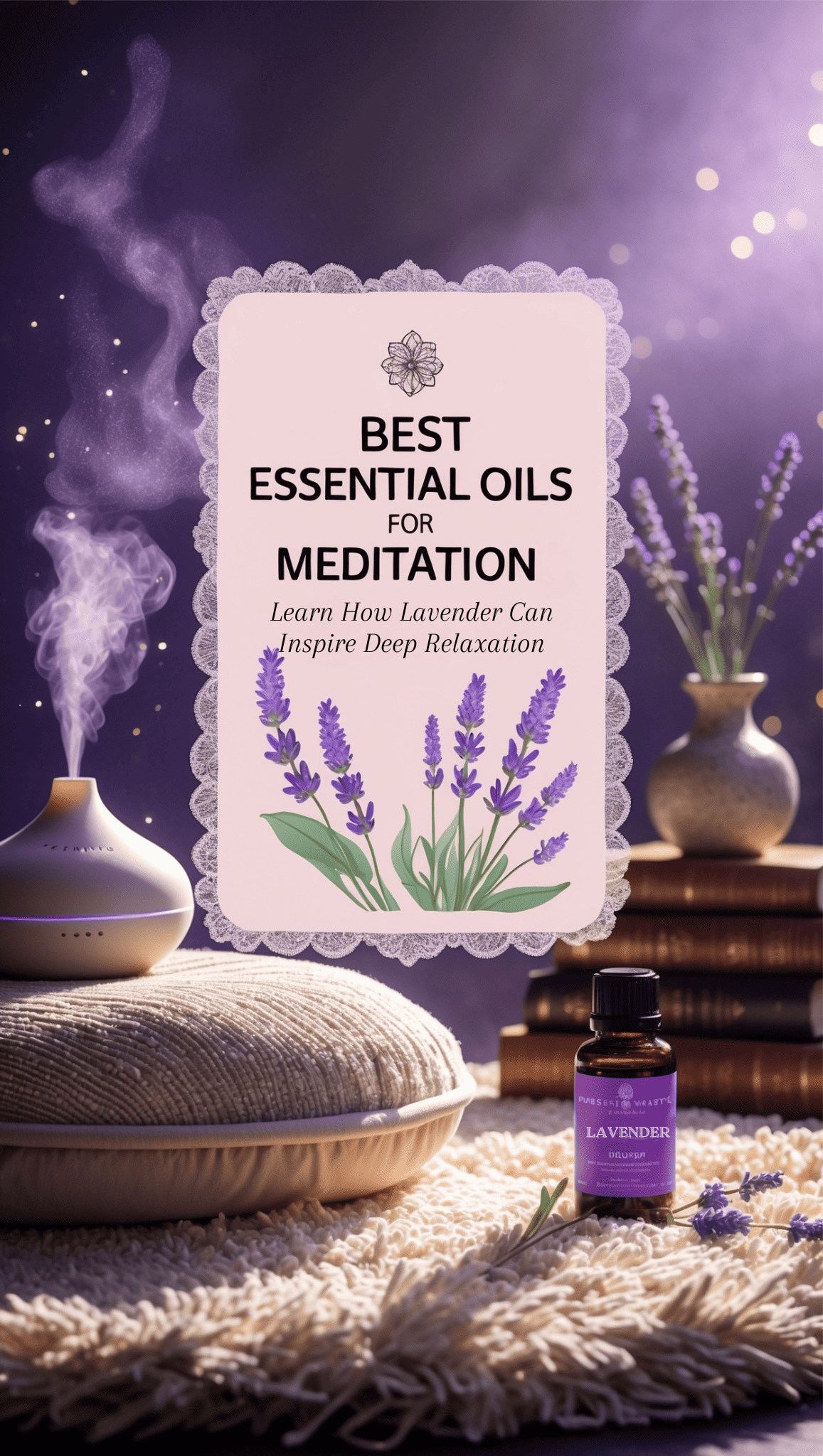
Lavender was my gateway into the world of essential oils, and it remains my most reliable companion for those evenings when my mind refuses to slow down after a chaotic day. There’s something about its perfect balance—not too floral, not too medicinal—that seems to speak the universal language of relaxation to almost everyone!
When I first started teaching meditation classes, I noticed how the simple addition of lavender diffused in the room would help even the most fidgety beginners find stillness more quickly. Its ability to gently calm the nervous system while keeping you present (rather than sleepy) makes it my top recommendation for new meditators.
What fascinates me most about lavender is how versatile it is across different meditation styles. Whether I’m practicing a focused concentration technique or a more open awareness meditation, lavender seems to enhance the experience without imposing itself too strongly. I’ve even noticed that using lavender before bedtime meditation helps bridge my practice into restful sleep afterward.
While some spiritual traditions favor more exotic or resinous scents, I find there’s profound wisdom in starting with this humble purple flower that grows in so many places around the world.
Calming Properties for Anxious Minds
Lavender contains natural compounds like linalool that have been scientifically shown to reduce anxiety and stress hormones.
Versatility Across Meditation Styles
This adaptable oil enhances both active daytime practices and evening wind-down meditations.
Blending Lavender for Enhanced Effects
Combine with frankincense for spiritual depth or bergamot for an uplifting dimension to your practice.
How to Use Lavender in Your Meditation Practice
- Add 3-5 drops to your diffuser 10 minutes before beginning meditation
- Create a meditation mist by adding 10 drops to 2oz of water in a spray bottle
- Place a single drop on your meditation cushion or blanket
- For deeper relaxation, apply a diluted drop to the back of your neck before practice
- Combine with equal parts frankincense for an enhanced spiritual connection
Picture This
You settle onto your meditation cushion as the delicate lavender mist surrounds you like a protective cocoon. With each inhale, you feel the day’s tensions dissolving, your shoulders softening, your mind clearing of its usual chatter. The lavender notes—sweet, herbaceous, and gently floral—create an invisible sanctuary where your breath deepens naturally and your meditation unfolds with unusual clarity, all supported by one of the best essential oils for meditation practice.
2. Frankincense Essential Oil: Ancient Wisdom for Spiritual Grounding
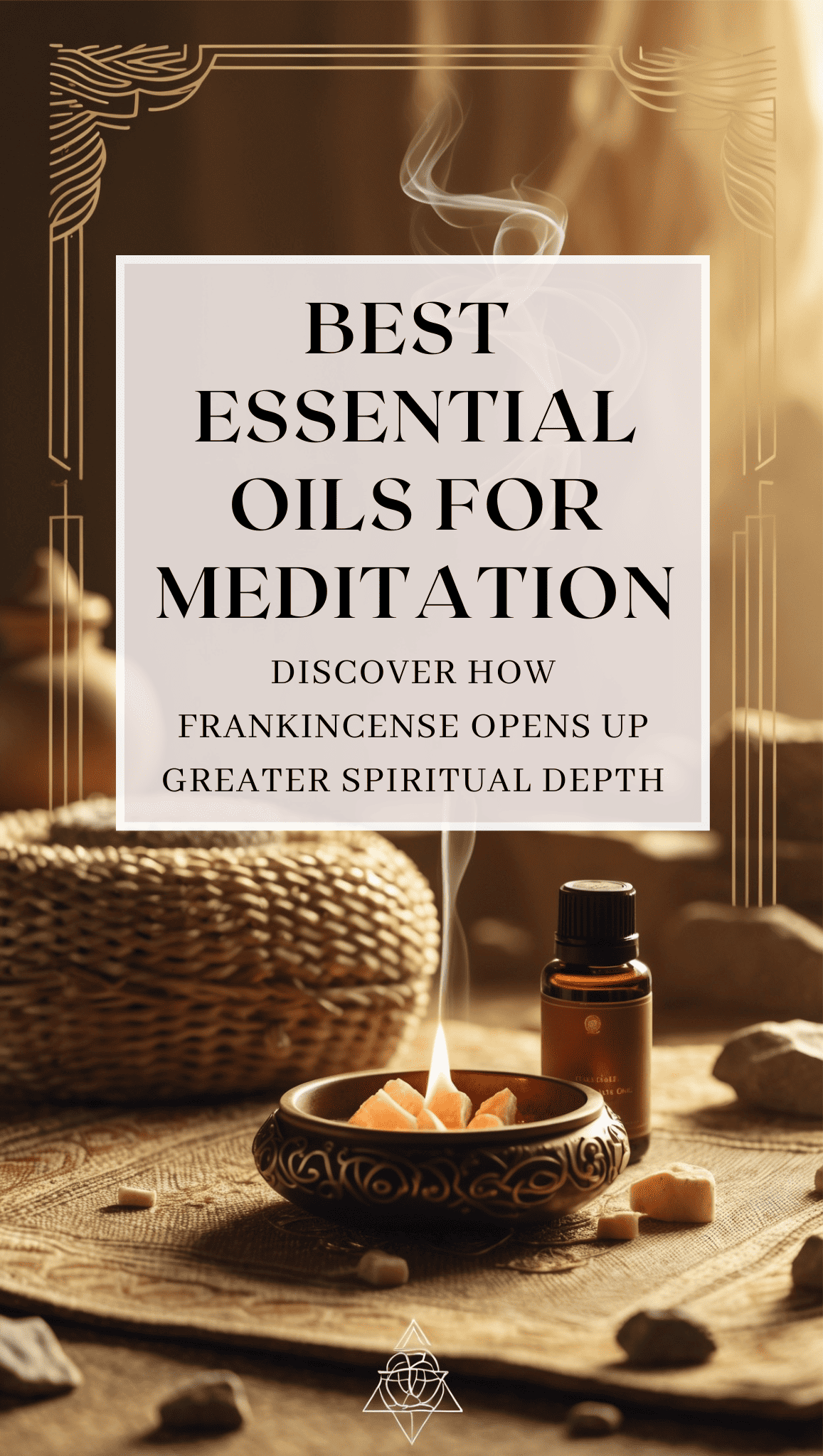
I’ll never forget my first experience with frankincense during a meditation retreat in the mountains. The moment that rich, resinous aroma filled our practice space, something profound shifted in the energy of the room! This ancient oil has been burned in temples and sacred ceremonies for thousands of years, and after experiencing its effects firsthand, I completely understand why.
Whenever my meditation practice feels scattered or superficial, frankincense helps me drop below the surface chatter into deeper waters of awareness. There’s a reason this precious resin was considered more valuable than gold in ancient times—its ability to facilitate spiritual connection is truly priceless.
What I love most about frankincense is its grounding quality that simultaneously helps elevate consciousness. It seems contradictory, but this special resin somehow anchors you firmly in your body while opening doorways to more expansive states of awareness. I’ve noticed that regular use of frankincense during my meditation actually helps maintain that connected feeling between sessions too.
Though it’s one of the more expensive oils in my collection, a little goes an incredibly long way, and I consider it an essential investment in my spiritual practice rather than a luxury. The depth it brings to meditation is simply unmatched by most other oils.
Historical Spiritual Significance
Used in religious ceremonies across diverse cultures for thousands of years, frankincense has an unparalleled history of facilitating spiritual connection.
Respiratory Support for Deeper Breathing
The natural compounds in frankincense help open airways and support the deep, rhythmic breathing essential for meditation.
Elevating Consciousness While Grounding
This unique oil simultaneously anchors you in your body while creating space for expanded awareness.
How to Work with Frankincense for Meditation
- Place 2-3 drops in your diffuser for a subtle but powerful presence
- Create a grounding blend by combining with cedarwood and sandalwood
- For traditional use, warm a resin form of frankincense on a charcoal disc
- Apply a drop (properly diluted) to the crown of your head before meditation
- Keep a personal inhaler with frankincense for meditation on the go
Picture This
The ancient, resinous warmth of frankincense fills your meditation space, immediately creating an atmosphere that feels both sacred and familiar—as if it carries the whispered prayers of countless seekers through the centuries. As you close your eyes and breathe deeply, this most revered of the best essential oils for meditation seems to create an invisible pillar of light connecting earth to sky through your straight spine, grounding your body while your consciousness expands into clarity and stillness.
3. Sandalwood Essential Oil: Sacred Support for Deeper Meditation

My relationship with sandalwood began during a challenging period when my meditation practice felt more like a battle than a sanctuary. A teacher suggested I try incorporating this precious oil, and the difference was immediate and profound! There’s a reason sandalwood has been used in Eastern spiritual traditions for centuries—its warm, woody aroma creates an immediate sense of sanctuary and reverence.
Diffusing sandalwood helps you to maintain focus during longer meditation sessions when your mind would typically begin to wander. The subtle sweetness beneath its woody character seems to nourish something deep within that helps sustain your practice through difficult emotions or restlessness.
What particularly draws me to sandalwood is its ability to enhance meditation without being overpowering or distracting. Unlike some stronger oils that might pull your attention outward to the scent itself, sandalwood creates a subtle atmosphere that supports inward focus. I’ve noticed it’s especially helpful when I’m working with heart-centered or devotional practices, as it seems to soften the boundaries around my usual sense of self.
While true, sustainably harvested sandalwood oil is quite expensive, I’ve found that even a single drop used mindfully can transform an entire meditation session, making it a worthwhile investment for serious practitioners.
Opening the Third Eye Chakra
Traditionally associated with the sixth chakra, sandalwood supports visualization, intuition, and spiritual insight.
Mental Clarity and Focus Enhancement
The sesquiterpene compounds in sandalwood have been shown to stimulate the pineal gland and improve mental clarity.
Emotional Balance and Centeredness
This grounding oil helps calm emotional turbulence that might otherwise disrupt meditation.
How to Incorporate Sandalwood Into Meditation
- Add 1-2 drops to your diffuser (less is more with this potent oil)
- Create a meditation blend with equal parts sandalwood and frankincense
- Place a single drop on a wooden mala or prayer beads
- For traditional practice, place a drop on the third eye area (diluted appropriately)
- Seek sustainable Australian sandalwood as an ethical alternative to endangered Indian varieties
Picture This
The rich, creamy aroma of sandalwood enfolds you like an ancient temple carved from living wood. As you settle into meditation, this most sacred of the best essential oils for meditation seems to melt the boundary between inner and outer worlds. Your mind, usually jumping between thoughts, finds an unusual stillness—like a deer appearing in a sun-dappled forest clearing—and your awareness expands with each breath into a space of clarity and presence that feels both vast and intimately familiar.
4. Ylang Ylang Essential Oil: Heart-Opening Properties for Loving-Kindness Meditation
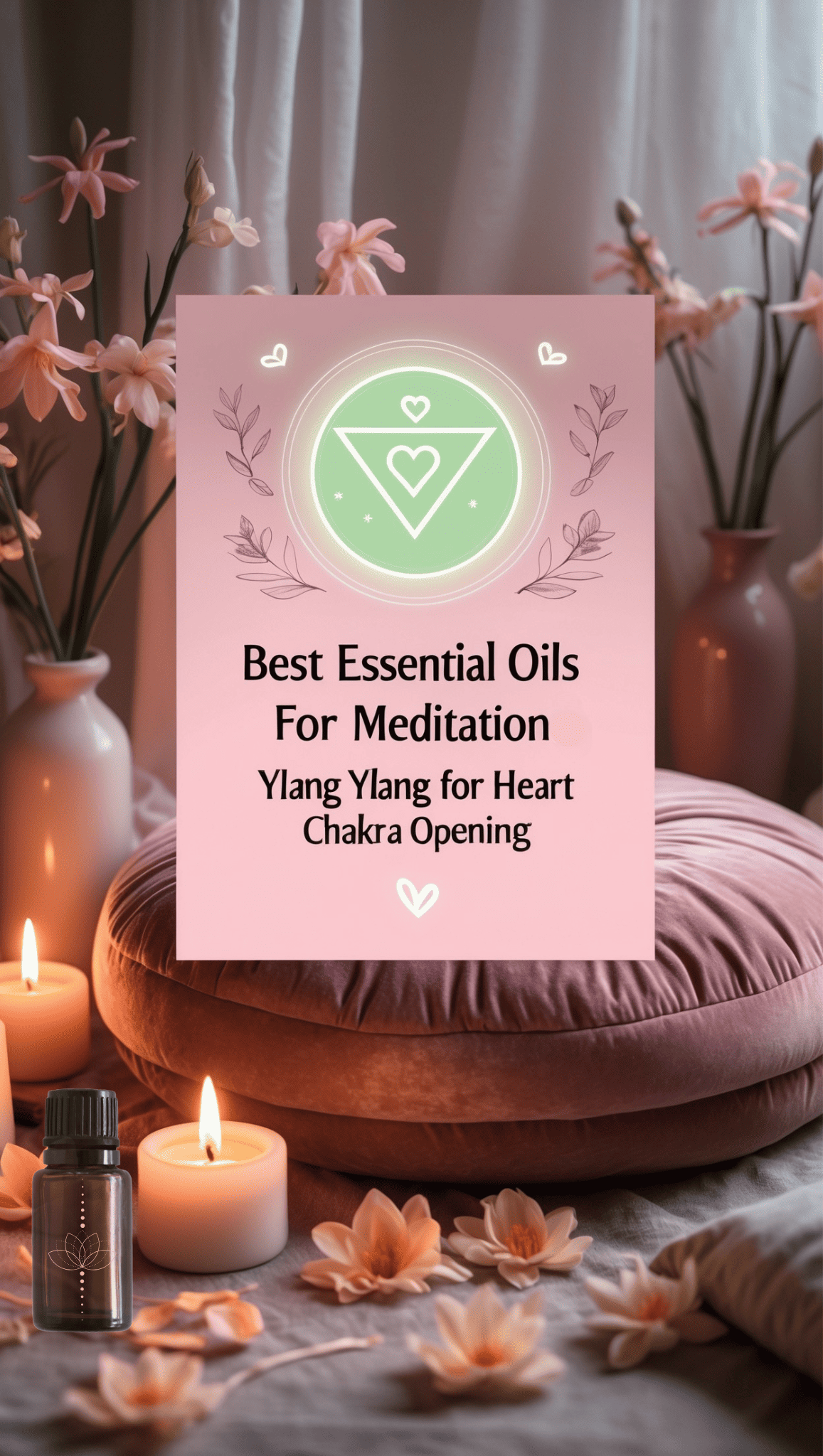
I discovered ylang ylang during a particularly difficult time when my heart felt closed and my meditation practice had become mechanical rather than nourishing. The first time I diffused this exotic floral oil, I was taken aback by its intensity—and honestly, I wasn’t sure if I liked it! But something remarkable happened as I sat with it: layers of emotional armor I didn’t even realize I was carrying began to soften.
Now, whenever I’m practicing loving-kindness meditation or working with clients on heart-centered awareness, ylang ylang is my go-to ally. Its sweet, almost hypnotic quality helps bypass the analytical mind and speak directly to the emotional body. What I’ve come to appreciate most about ylang ylang is how effectively it bridges the gap between emotional healing and spiritual practice.
In our achievement-oriented culture, we often approach meditation as another self-improvement project, focusing on technique while neglecting the heart. I’ve found that ylang ylang gently redirects attention to what truly matters in spiritual practice—opening to greater love and compassion.
While its intense floral aroma can be overwhelming used alone, blending just a drop with more grounding oils creates a balanced atmosphere that supports emotional depth without becoming overwhelming or sentimental.
Emotional Release and Processing
Ylang ylang helps dissolve emotional blockages that may be preventing deeper meditation experiences.
Heart Chakra Activation
This oil resonates specifically with the heart center, enhancing meditations focused on love and compassion.
Balancing Feminine and Masculine Energies
Ylang ylang helps harmonize polarities within consciousness for more integrated meditation.
How to Work with Ylang Ylang in Meditation
- Use sparingly—add just 1 drop to your diffuser along with grounding oils
- Create a heart-opening blend with rose and sandalwood
- Practice loving-kindness meditation while diffusing ylang ylang
- Apply a properly diluted drop over the heart area before meditation
- For sensitive individuals, simply place a drop on a cotton ball near your meditation space
Picture This
As the exotic, honeyed notes of ylang ylang bloom in your meditation space, you notice an almost immediate softening around your heart. This powerfully feminine essence—one of the best essential oils for meditation focused on compassion—seems to melt the invisible armor you’ve been carrying. With each breath, your meditation deepens not through force of concentration but through surrender, as ancient walls around your heart dissolve and your practice becomes less about doing and more about being fully present with whatever arises.
5. Patchouli Essential Oil: Grounding Energy for Spiritual Stability
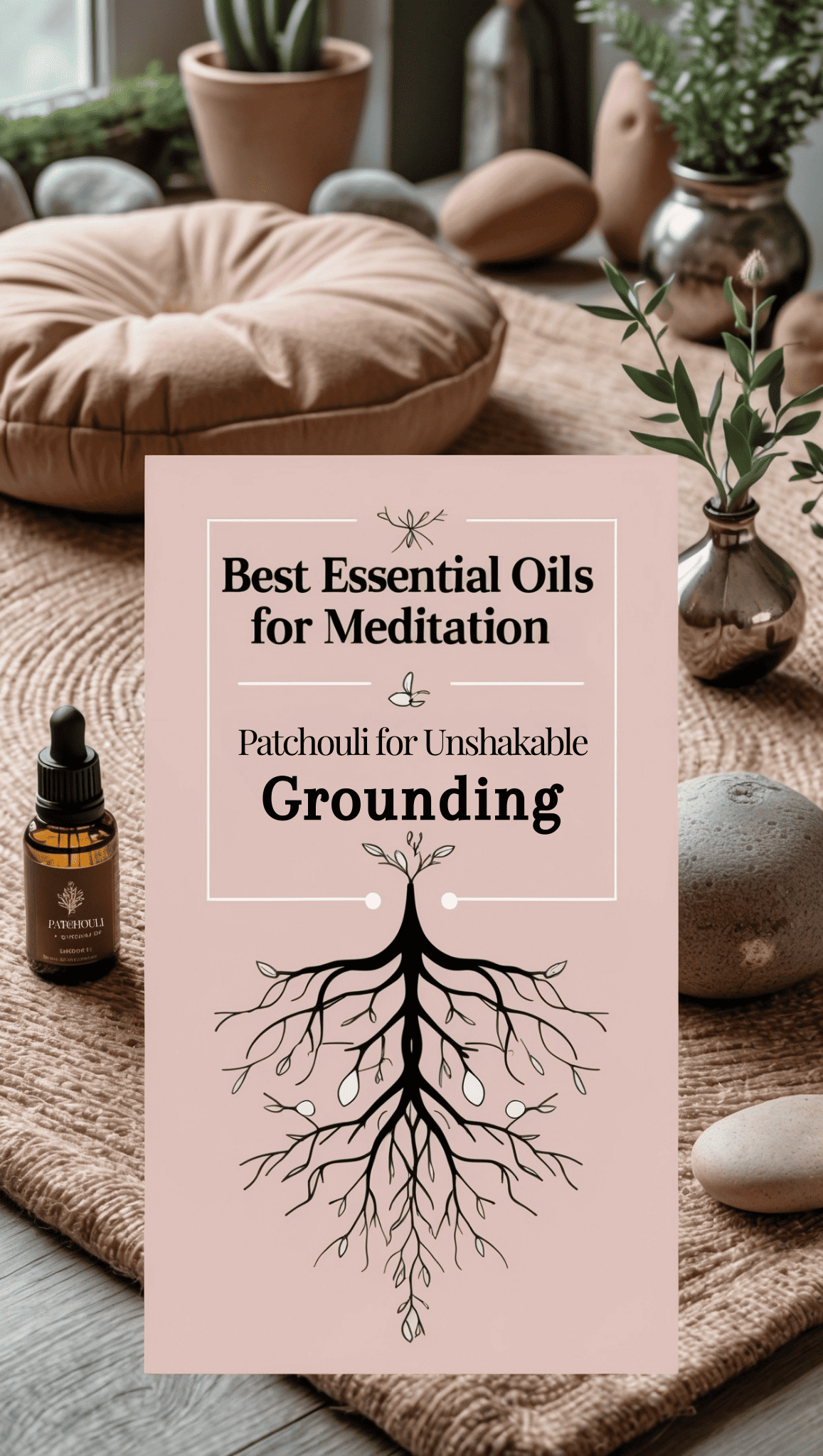
My relationship with patchouli has completely transformed over the years—from associating it with hippie culture to discovering its profound benefits for my spiritual practice! When I first incorporated this earthy oil into my meditation routine, I was amazed by how quickly it helped me feel physically present and emotionally centered.
On days when when your energy feels scattered or when overthinking, patchouli helps bring you back to your body and the present moment almost immediately. There’s something almost magical about how it seems to create a sense of having roots extending deep into the earth, which creates the perfect foundation for exploring higher states of consciousness.
What I particularly value about patchouli is its effectiveness for grounding during challenging meditations that bring up difficult emotions or insights. I’ve found it especially helpful when working with shadow aspects or when processing grief during practice.
While some find its distinctive aroma too strong or reminiscent of certain cultural associations, I encourage giving it a fresh chance in your spiritual practice. The quality and aging of patchouli makes an enormous difference in its scent profile—a well-aged, high-quality oil has a sophisticated depth that bears little resemblance to the overwhelming fragrance sometimes associated with it. When used mindfully, it creates an unshakable foundation for spiritual exploration.
Earth Element Connection
Patchouli resonates strongly with the earth element, helping establish stability during meditation.
Mental Chatter Reduction
The sesquiterpenes in patchouli help slow racing thoughts that can interfere with meditation.
Energetic Protection and Boundaries
This oil helps establish and maintain energetic boundaries during deep meditation work.
How to Use Patchouli for Grounded Meditation
- Add 2 drops to your diffuser along with a citrus oil to balance its earthiness
- Create a grounding blend with equal parts patchouli, vetiver, and cedarwood
- Apply a diluted drop to the soles of your feet before meditation
- Place a drop on a lava stone or clay diffuser near your meditation space
- For a lighter touch, place one drop in your diffuser with 3 drops of lavender
Picture This
The rich, earthy embrace of patchouli wraps around you like fertile soil supporting new growth. As you settle into meditation, you feel an almost magnetic pull drawing scattered energy downward, collecting it back into your center. With each breath, this grounding champion among the best essential oils for meditation helps you establish unshakable presence—like an ancient tree whose roots reach deep into the earth even as its branches sway in passing winds of thought and emotion.
6. Cedarwood Essential Oil: Ancient Wisdom for Wisdom Meditation

The first time I experienced cedarwood in meditation was during a retreat in a mountain cabin surrounded by towering trees. Something about this oil’s aroma transported me to an inner landscape of profound wisdom and quiet knowing! Cedarwood has been my faithful companion ever since for meditations where I’m seeking clarity or insight rather than just relaxation.
There’s a dignified quality to its scent—like being in the presence of an ancient teacher who doesn’t need many words to convey deep truth. When my practice feels shallow or when I’m seeking deeper understanding rather than just peace, cedarwood helps me access those wisdom-oriented states of consciousness.
What I appreciate most about cedarwood is its subtle strength and endurance. Unlike some oils that make a dramatic entrance but fade quickly, cedarwood creates a steady, unwavering presence throughout your entire meditation session. I’ve noticed it’s particularly supportive when I’m contemplating life decisions or seeking to connect with my inner guidance.
While not as famous in spiritual practice as frankincense or sandalwood, cedarwood deserves equal recognition for its unique ability to combine mental clarity with spiritual depth. I find it especially effective when diffused in combination with juniper berry or cypress for meditation focused on receiving intuitive wisdom.
Ancestral Connection and Wisdom
Cedarwood helps establish connections to ancestral wisdom and collective knowledge.
Mental Clarity and Focus
The sesquiterpenes in cedarwood support brain function and clear thinking during meditation.
Strengthening Spiritual Resolve
This oil reinforces determination and commitment to regular spiritual practice.
How to Incorporate Cedarwood in Wisdom Meditation
- Add 3-4 drops to your diffuser for a steady, subtle presence
- Create a wisdom-enhancing blend with sage and juniper berry
- Place a drop on wooden meditation beads or malas
- Diffuse during journaling sessions after meditation to capture insights
- Use Atlas cedarwood (Cedrus atlantica) for its particularly refined aroma
Picture This
The woody, balsamic notes of cedarwood fill your meditation space with an atmosphere of timeless wisdom—as if you’re sitting within the heart of an ancient forest where the trees themselves are meditation masters. As your practice deepens, this stalwart among the best essential oils for meditation seems to activate a quiet knowing deep within you. Your thoughts naturally slow and clarify, leaving space for intuitive wisdom to emerge from the silence between them, steady and unwavering like the cedarwood trees themselves.
7. Bergamot Essential Oil: Uplifting Support for Mindfulness Meditation
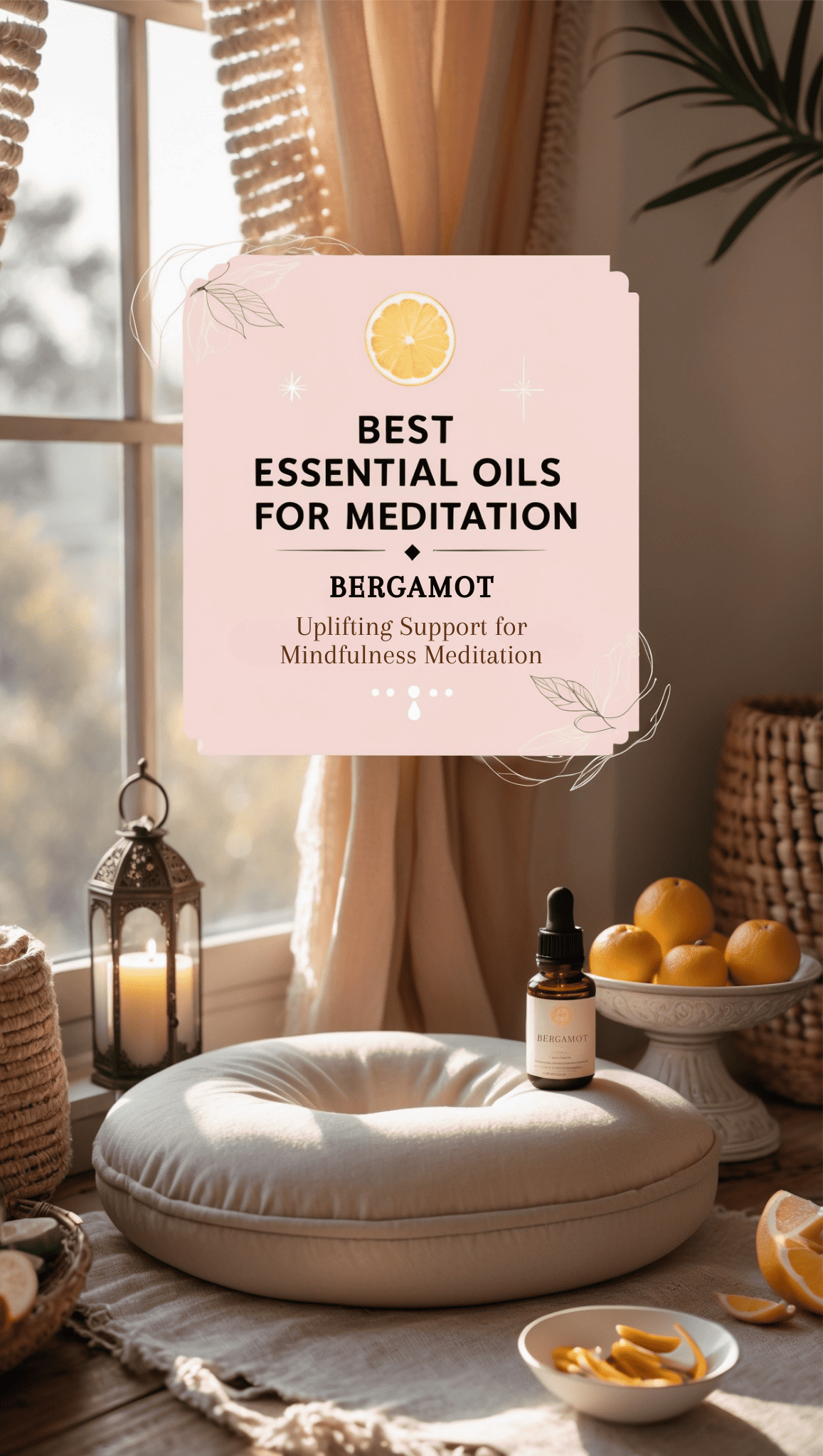
I discovered bergamot during a period when my meditation practice felt heavy and overly serious—I was putting so much effort into “doing it right” that I’d lost the joy and lightness that initially drew me to spiritual practice! The first time I diffused this citrusy gem before meditating, I was amazed by how it lifted my mood without making me distracted.
Unlike some uplifting oils that can make it harder to sit still, bergamot somehow manages to elevate your spirits while simultaneously helping you remain present and focused. Now it’s my essential companion for morning meditation or any practice where I’m working with others who are navigating difficult emotions that need a touch of light and hope.
What fascinates me most about bergamot is its paradoxical nature—it’s simultaneously calming and uplifting, making it ideal for mindfulness practices where you want to remain alert yet relaxed. I’ve found it particularly helpful when teaching meditation to beginners who often struggle with feeling either too sleepy or too wired during practice.
The fresh, bright quality of bergamot creates an atmosphere that makes presence feel inviting rather than like a discipline to be endured. While other citrus oils can sometimes feel too stimulating for meditation, bergamot has a unique floral undertone that balances its zesty nature perfectly for spiritual practice.
Anxiety Reduction Without Sedation
Bergamot reduces stress hormones while maintaining mental clarity and alertness.
Emotional Balance and Upliftment
This oil helps lift depression and heaviness without creating an artificially elevated state.
Support for Mindfulness Practice
Bergamot’s balanced energy enhances present-moment awareness without causing distraction.
How to Use Bergamot for Bright Awareness
- Add 3-4 drops to your diffuser for morning meditation practice
- Create an uplifting blend with lavender and frankincense
- Place a drop on a tissue and inhale directly before meditation
- Remember bergamot is photosensitive—avoid sun exposure if applied to skin
- For meditation during difficult emotional times, combine with ylang ylang
Picture This
Sunlight captured in oil form, bergamot’s bright citrus notes dance in your meditation space, infusing the air with gentle optimism. As you settle into practice, this mood-lifting member of the best essential oils for meditation collection creates a sanctuary where awareness feels effortless rather than forced. Each breath brings clarity without tension, alertness without strain—a perfect balance of lightness and presence that allows your meditation to unfold with natural brightness, like morning light illuminating a previously shadowed room.
8. Clary Sage Essential Oil: The Visionary’s Aid for Transcendental Meditation
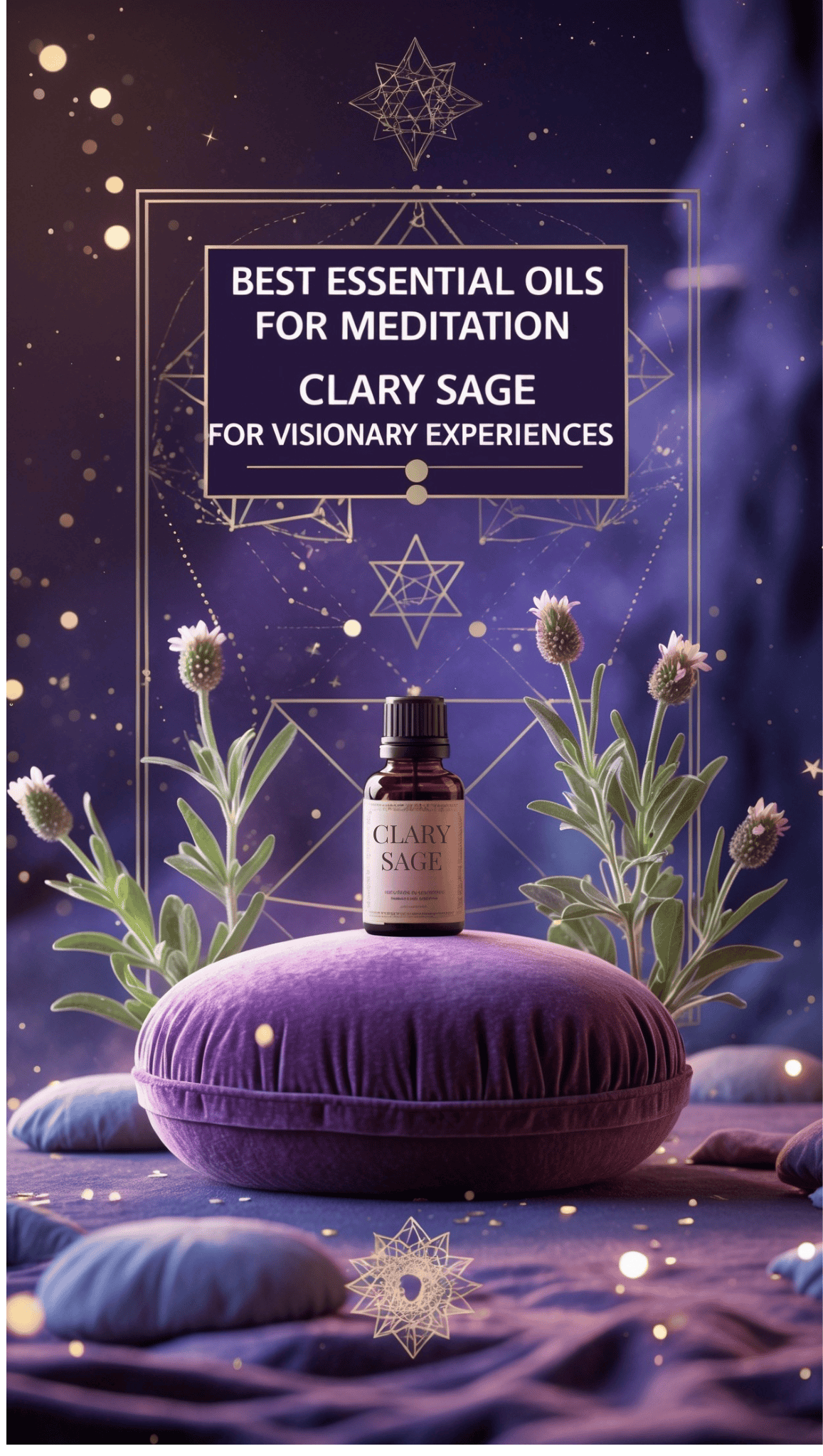
My introduction to clary sage came during a vision quest retreat where it was used to enhance dream work and intuitive practices. I was initially surprised by its unusual aroma—herbaceous, almost wine-like, with an ethereal quality unlike any other oil I’d experienced!
That night, my meditation and subsequent dreams took on a vivid, meaningful quality that felt like direct communication from my deeper self. Since then, clary sage has become my secret weapon for meditations where I’m specifically working with visualization, seeking creative solutions, or attempting to access non-ordinary states of consciousness. There’s something about this peculiar oil that seems to thin the veil between different levels of awareness.
What I value most about clary sage is how it supports meditative states that transcend ordinary thinking without becoming sleepy or ungrounded. I’ve found it particularly effective for chakra visualization practices or any meditation involving inner journeying.
While its distinctive scent might not appeal to everyone immediately, I encourage sitting with it over time as its benefits often reveal themselves gradually. I’ve noticed that women especially tend to resonate with clary sage, perhaps because of its balancing effect on hormonal systems that can otherwise create fluctuations in our meditation experiences. When I’m feeling stuck in logical thinking patterns that limit my spiritual practice, clary sage helps me access more intuitive, non-linear ways of knowing.
Enhanced Visualization Abilities
Clary sage supports the formation of clear mental images during visualization meditation.
Dream Work and Intuition
This oil strengthens the connection between conscious and subconscious mind states.
Third Eye and Crown Chakra Activation
Traditionally used to enhance spiritual sight and connection to higher consciousness.
How to Work with Clary Sage for Visionary Meditation
- Use just 1-2 drops in your diffuser—its effects are potent
- Create a visionary blend with frankincense and a touch of lemon
- Practice visualization or guided meditation while diffusing
- For dream work, place a drop on your pillowcase before bedtime meditation
- Combine with lavender to balance its strong ethereal properties
Picture This
The mysterious, herbaceous notes of clary sage create an atmosphere of gentle transformation in your meditation space. As you close your eyes, this visionary ally among the best essential oils for meditation seems to dissolve the boundaries of ordinary perception. Your mind’s eye awakens with unusual clarity—colors become more vivid in your visualizations, intuitive insights arise effortlessly, and your meditation takes on a numinous quality that bridges the conscious and subconscious realms, opening doorways to wisdom beyond logical thinking.
Creating Effective Essential Oil Blends for Different Meditation Styles
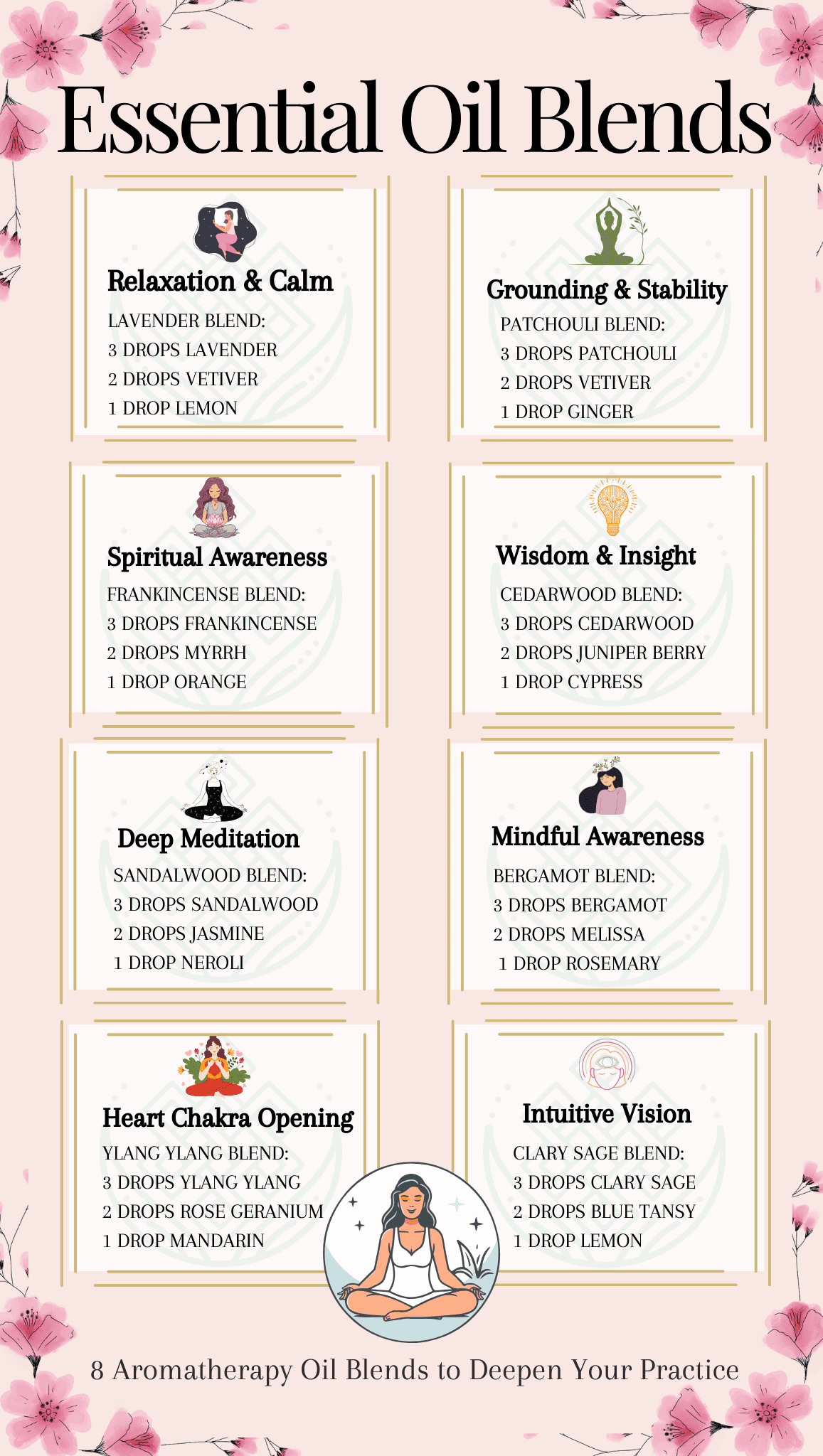
When I first started experimenting with essential oils for meditation, I made the classic beginner mistake of combining too many oils at once, creating overwhelming blends that distracted rather than enhanced my practice! Through years of trial and error, I’ve discovered that simplicity is the key to creating effective meditation blends.
Some of my most profound experiences have come from combinations of just two or three oils that complement each other perfectly. I’ve learned to think of blending as a form of meditation itself—tuning in to what my spirit needs that day and selecting oils that will support my specific intention, whether that’s grounding, heart-opening, or accessing deeper wisdom.
What I love about creating personalized blends is how they can be tailored to different meditation styles and goals. I keep a small meditation journal where I note which combinations work particularly well for specific practices. Over time, I’ve noticed fascinating patterns—for instance, how adding a single drop of bergamot to a grounding blend completely transforms my morning practice, or how the addition of vetiver helps me maintain focus during longer sitting periods.
Don’t be afraid to experiment beyond traditional “spiritual” oils too! I’ve found that unexpected additions like black pepper can add remarkable dimension to meditation blends by increasing circulation and awareness in the body.
Understanding Oil Compatibility and Notes
Learn to combine top, middle, and base notes for balanced blends that evolve throughout your meditation session.
Blending by Meditation Purpose
Create specific blends for different practices like grounding, heart-centered, or transcendental meditation.
Seasonal and Circadian Considerations
Adjust your meditation blends to support your energy with the changing seasons and times of day.
How to Create Personalized Meditation Blends
- Start with a base of grounding oils like frankincense or cedarwood (40% of your blend)
- Add heart-centering oils like lavender or rose (30-40% of your blend)
- Finish with a small amount of uplifting oils like bergamot or clary sage (20-30%)
- Test blends on a paper strip before diffusing to ensure harmonious scent profiles
- Keep a meditation journal noting which blends support different types of practice
Picture This
Your hand reaches for three small amber bottles, intuitively selecting exactly what your practice needs today. As the first drops fall into the diffuser—frankincense, lavender, and a touch of bergamot—they begin to merge into something greater than their individual parts. This personalized harmony of the best essential oils for meditation rises to meet you as you settle onto your cushion, creating an aromatic sanctuary perfectly attuned to your intention. With each breath, the blend evolves slightly, supporting different phases of your practice as you journey from external awareness to the still point within.
Best Diffusers and Application Methods for Meditation Spaces
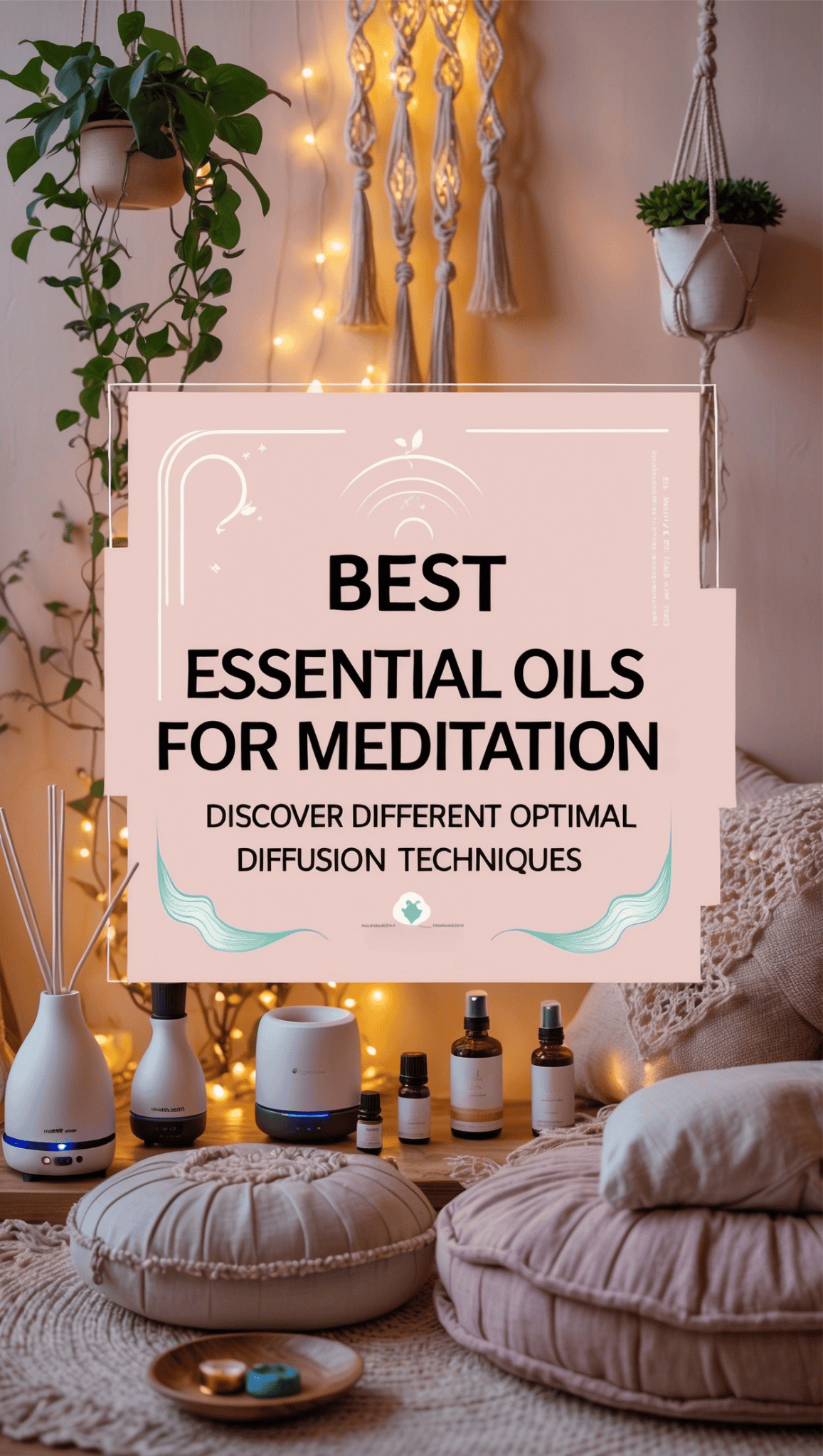
My essential oil journey began with a cheap plastic diffuser that broke within months and distributed scent unevenly throughout my meditation space. What a difference it made when I finally invested in a high-quality ultrasonic diffuser with a timer function! I quickly discovered that how you diffuse oils is just as important as which oils you select.
The gentle mist from a good ultrasonic diffuser creates a subtle, consistent aromatherapy experience that supports meditation without becoming overpowering or distracting. I particularly value diffusers with timer settings that align with my meditation duration—allowing me to set it and then completely forget about it during practice.
While diffusers are wonderful for creating an aromatic atmosphere, I’ve found that personal inhalation methods can create an even more intimate connection with essential oils during meditation. One of my favorite discoveries was making a small meditation inhaler that I can use for a direct dose of support whenever my practice needs refocusing.
For certain oils with specific energy centers, I’ve experienced profound results from the traditional practice of applying diluted oils to corresponding points on the body before meditation. Whatever method you choose, remember that subtlety is key—the oils should enhance your meditation experience, not dominate your awareness or pull your attention outward to the scent itself.
Understanding Diffuser Types and Benefits
Compare ultrasonic, nebulizing, and evaporative diffusers for different meditation environments and goals.
Personal Inhalation Methods
Discover how personal inhalers and direct palm inhalation create intimate connections with oils during practice.
Topical Application for Chakra Work
Learn safe dilution practices for applying oils to specific energy centers before meditation.
How to Optimize Your Essential Oil Delivery Method
- Position your diffuser slightly above head height for optimal distribution
- Set timers to run intermittently during longer meditation sessions
- Create a meditation inhaler with a blank inhaler tube and 15-20 drops of your favorite blend
- For topical application, always dilute oils to 2% in a carrier oil (10-12 drops per ounce)
- Experiment with passive diffusion methods like reed diffusers for subtle, continuous aroma
Picture This
Your meditation space is prepared with intention—a beautiful ceramic diffuser sending whispers of sacred oils into the air at precisely the right intensity. As you begin your practice, the aromatic molecules of the best essential oils for meditation dance invisibly around you, neither overwhelming nor barely perceptible, but perfectly balanced to support without distracting. The technology of the diffuser fades from awareness as the ancient wisdom of the plants speaks directly to your nervous system, creating the ideal conditions for your consciousness to expand beyond its usual boundaries.
Establishing a Sustainable Essential Oil Practice for Long-Term Spiritual Growth
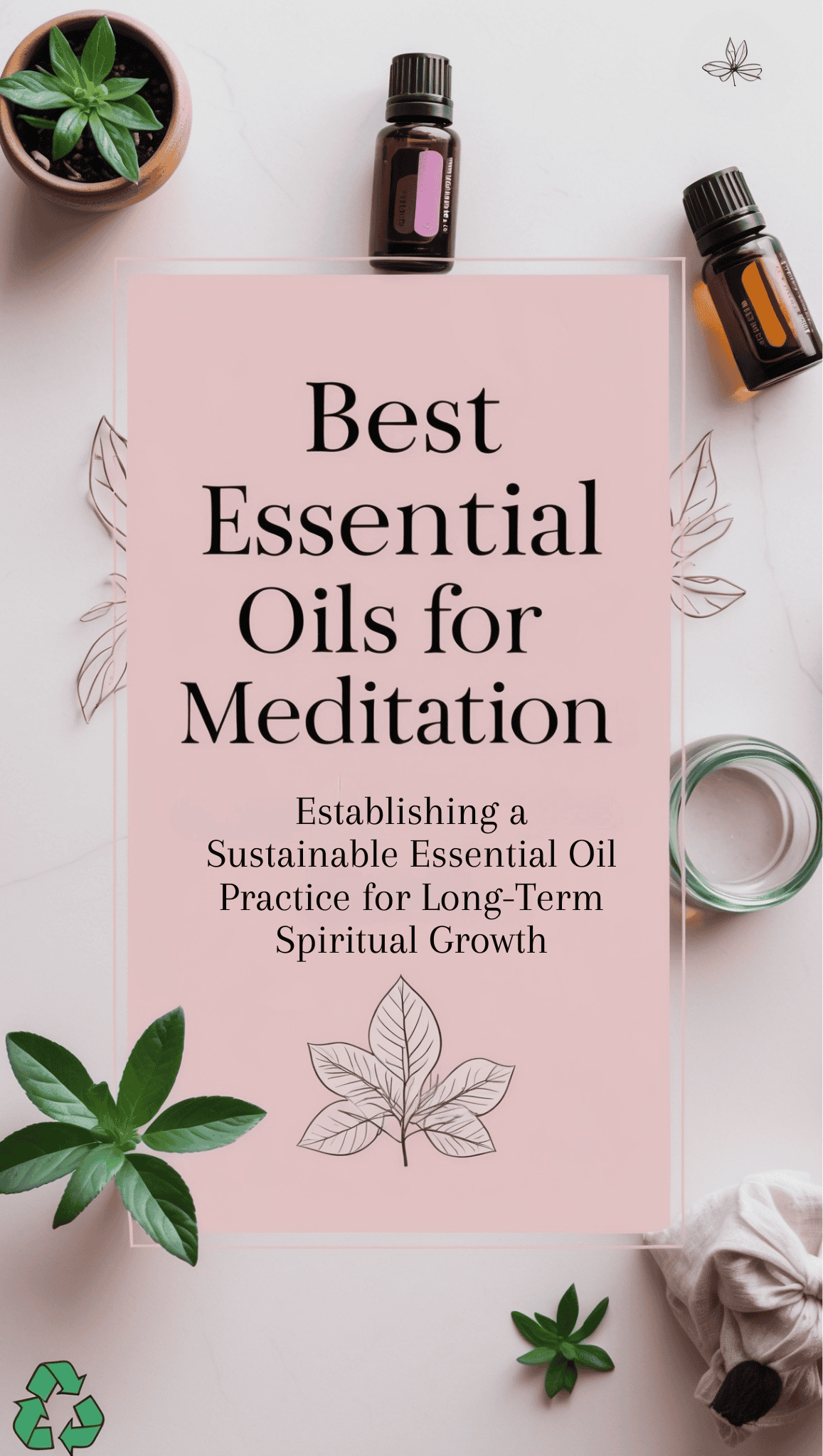
When I first fell in love with essential oils for meditation, I went overboard purchasing dozens of bottles without considering the environmental impact or sustainability of my new passion! As my spiritual practice deepened, I realized that mindfulness needed to extend to how I sourced and used these precious plant allies.
I began researching companies with transparent supply chains and ethical harvesting practices, even if it meant paying more for true quality. Now I view my essential oil collection as a sacred relationship with the plant kingdom rather than a consumer hobby. By choosing oils from sustainable sources, I feel a deeper connection during meditation—knowing that my practice isn’t coming at the expense of ecological balance. Another lesson I’ve learned about sustainability relates to how we use these concentrated botanical treasures. I used to diffuse oils constantly throughout the day, but now I save them primarily for meditation and specific spiritual practices.
This not only preserves these precious resources but also creates a special association that helps trigger my meditation state more effectively. I’ve discovered that rotating between different oils rather than using the same ones daily helps prevent sensitization and maintains their effectiveness. My current approach focuses on having fewer oils but using them with greater intention and awareness—which perfectly mirrors the principles of a mature meditation practice itself.
Ethical Sourcing and Environmental Impact
Research companies that prioritize sustainable harvesting, fair trade practices, and habitat preservation.
Economic Considerations for Long-Term Practice
Create a budget-conscious approach that prioritizes quality over quantity in your collection.
Creating Sacred Relationship with Plant Allies
Develop gratitude practices that acknowledge the gifts of the plants in your spiritual journey.
How to Build a Sustainable Essential Oil Practice
- Research companies that provide detailed information about sourcing and distillation
- Invest in fewer, higher-quality oils rather than many lower-quality options
- Learn which oils (like sandalwood) face sustainability challenges and seek alternatives
- Create a rotating system of oils to prevent sensitization and maintain effectiveness
- Consider growing some aromatherapy plants yourself to deepen your connection
Picture This
Your meditation altar holds just five carefully selected bottles of precious plant essences, each one chosen with tremendous care for both its spiritual properties and ecological footprint. As you open one and add a few drops to your diffuser, you take a moment to offer gratitude to the plants that provided this gift. The relationship with these best essential oils for meditation has evolved beyond mere consumption to become a meaningful exchange—the plants offering their wisdom and support to your spiritual practice, and you ensuring their continued existence through conscious, sustainable choices.
Final Thoughts
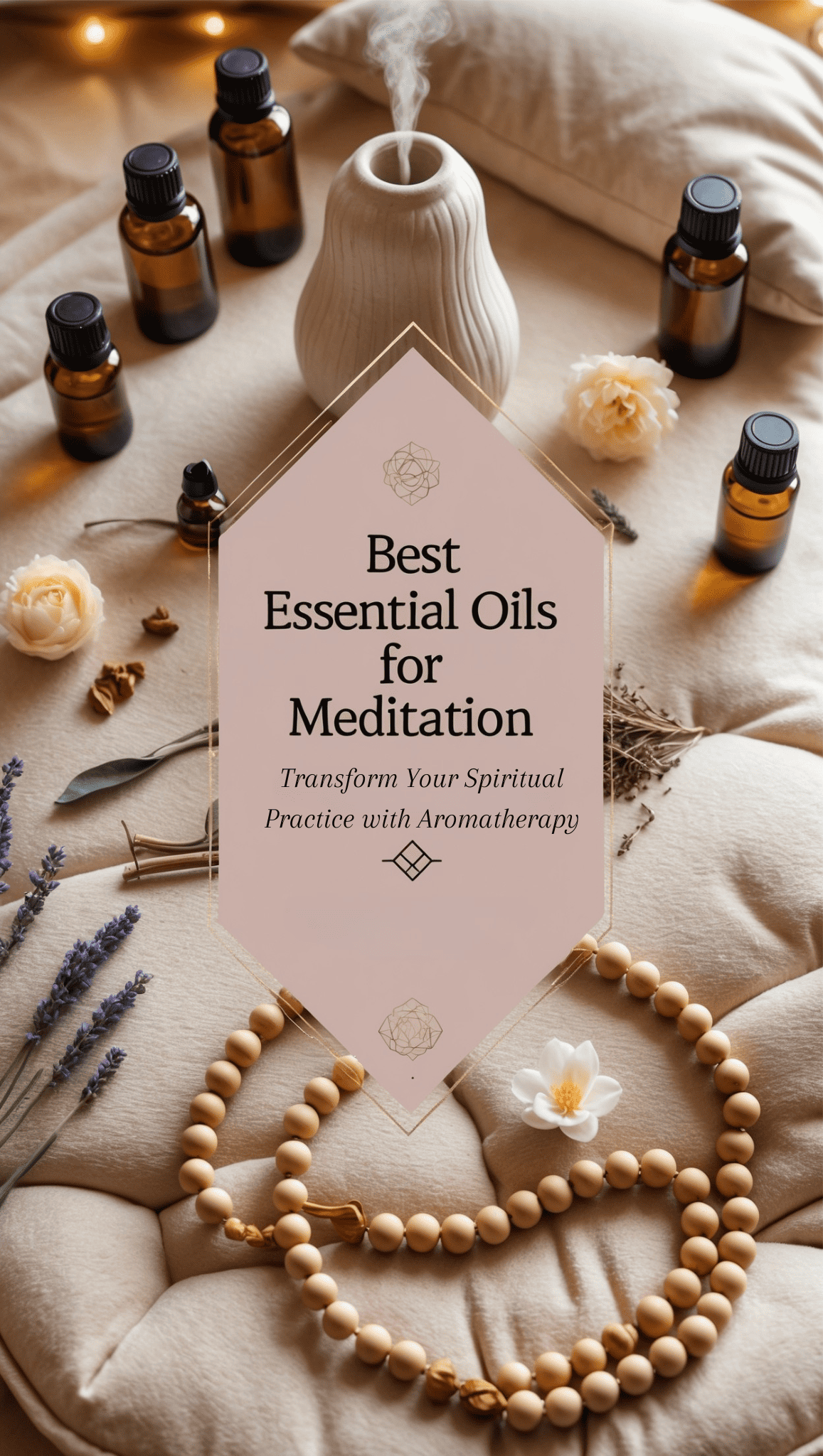
The journey of incorporating essential oils into your meditation practice is both an ancient tradition and a deeply personal exploration. Throughout history, spiritual seekers have recognized the powerful connection between aromatic plants and expanded states of consciousness, using scent as a bridge between worlds.
As you begin experimenting with these botanical allies, remember that your intuitive response to an oil is more important than any traditional assignment or recommendation! The best essential oil for your meditation practice is ultimately the one that helps you drop more easily into presence and stay there with greater clarity and depth.
Start small with just one or two oils that strongly resonate with your energy and meditation goals. Notice how they affect your practice over time, keeping a simple journal of your experiences if possible. Don’t be surprised if your relationship with certain scents evolves as your meditation practice deepens—oils that once seemed overwhelming might become powerful allies, while favorites might need to be set aside for different phases of your journey.
The beauty of combining aromatherapy with meditation lies in its elegant simplicity and profound depth. These plant essences offer their wisdom freely, creating an invisible sanctuary wherever you unroll your mat or cushion. May your explorations with the best essential oils for meditation bring new dimensions to your spiritual practice and support your journey toward greater awareness, peace, and connection!
This post may contain affiliate links. I only recommend products and services I genuinely believe in. Additionally, some images on this website may have been created with the help of AI to convey the feeling I wish to share with the reader.
FREQUENTLY ASKED QUESTIONS
Which essential oils are best for beginners starting a meditation practice?
Lavender, frankincense, and sweet orange are excellent choices for those new to both meditation and essential oils. Lavender provides gentle calming properties without overwhelming the senses, helping beginners relax into the practice more easily. Frankincense creates a natural sense of sacred space that can help establish a meditation habit by signaling to your brain that it’s time for spiritual practice, while sweet orange offers an uplifting quality that helps combat the restlessness many beginners experience during their first meditation sessions.
How can I tell if I’m buying high-quality essential oils for meditation?
Look for oils that include the botanical name, extraction method, and country of origin on the label, as these details indicate transparency from the manufacturer. High-quality oils should smell complex and natural—not synthetic or one-dimensional—and the company should be willing to provide batch testing results or GC/MS reports when requested. Perhaps most importantly, trust your body’s response—quality oils should feel energetically alive and supportive of your practice, not cause headaches, irritation, or feel energetically “flat” when you use them.
Can essential oils help me achieve deeper meditation states?
Yes, certain essential oils can help shift your brainwave patterns toward the alpha and theta states associated with deeper meditation. Frankincense, sandalwood, and vetiver contain sesquiterpenes that may help oxygenate the brain and stimulate the limbic system, creating conditions more conducive to transcendent meditation experiences. Regular use of these oils creates a conditioned response over time, where your brain begins to associate these scents with meditative states, making it progressively easier to drop into deeper awareness with their support.
Is it better to diffuse oils or apply them topically for meditation?
Both methods have unique benefits—diffusion creates an atmospheric experience that evolves throughout your practice, while topical application (properly diluted) forms a more intimate connection with specific energy centers. For beginners, diffusion is generally more accessible and requires less knowledge about safe dilution practices, so starting with 3-5 drops in a diffuser placed near your meditation area is recommended. As you develop your practice, you might explore creating personal inhalers or diluted blends for pulse points that support your particular meditation goals, keeping in mind that different applications may better serve different meditation styles.
How do I create essential oil blends specifically for different types of meditation?
For grounding meditation, combine base notes like frankincense, cedarwood, and vetiver to create a stable foundation that helps combat mental chatter. Heart-centered practices like loving-kindness meditation benefit from middle notes such as lavender, rose, or ylang ylang that open emotional pathways while maintaining balance. For transcendental or visionary meditation, incorporate small amounts of ethereal oils like clary sage or blue tansy that help shift perception beyond ordinary awareness, always anchoring these lighter energies with at least one grounding oil to prevent spaciness or disconnection during your practice.
About The Author
Jahlila is a Transformational Whole Self and Wellness Lifestyle Empowerment Coach, a devoted mother, passionate writer, and a fervent advocate for holistic wellness. She is the creator of The Tri-Sync Method, a comprehensive coaching program designed to help women establish a personalized wellness and self-care lifestyle for enduring total health wellness.
Her journey has transitioned from focusing solely on health and fitness to embracing a broader mission: empowering women through holistic approaches that unite body, mind, and spirit. Jahlila is dedicated to teaching, coaching, writing, and speaking about how wellness intersects with a joyful, balanced life. Her mission is to motivate women to prioritize and achieve their wellness goals, fostering a deep connection between a vibrant lifestyle and true happiness. Ready to reclaim your vitality, achieve mental clarity, and embrace your wellness journey? Explore more at The Tri-Sync Method.Com
Don’t wait another day to start living your healthiest, happiest life. Schedule a Free Discovery Consultation with Jahlila today to explore how The Tri-Sync Method can transform your life. For additional questions or personalized guidance, please visit our Contact Page.

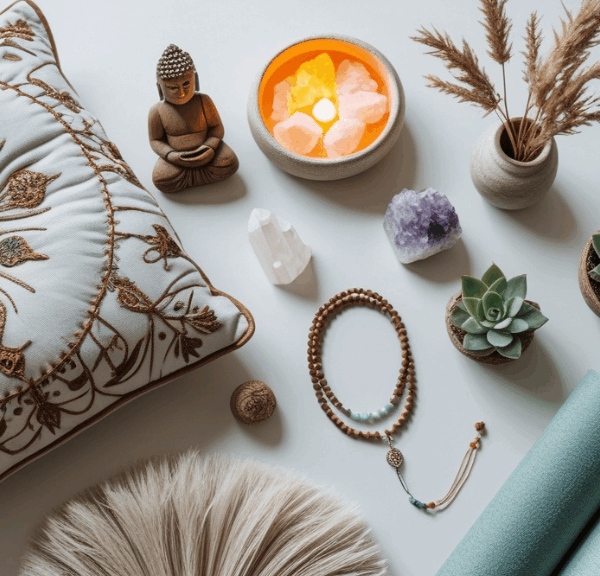
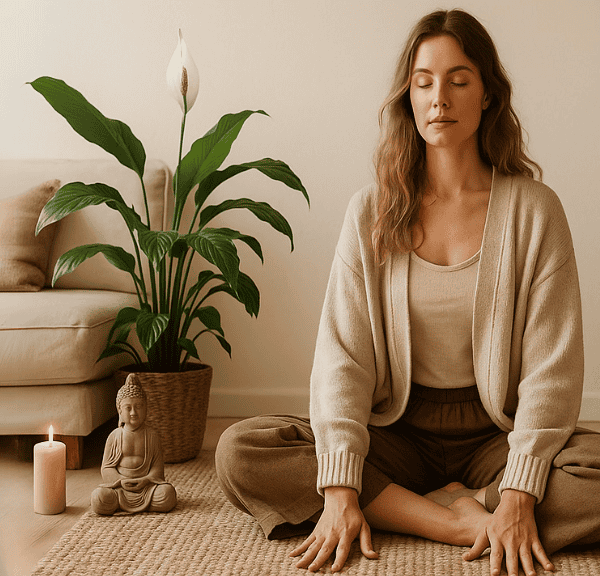
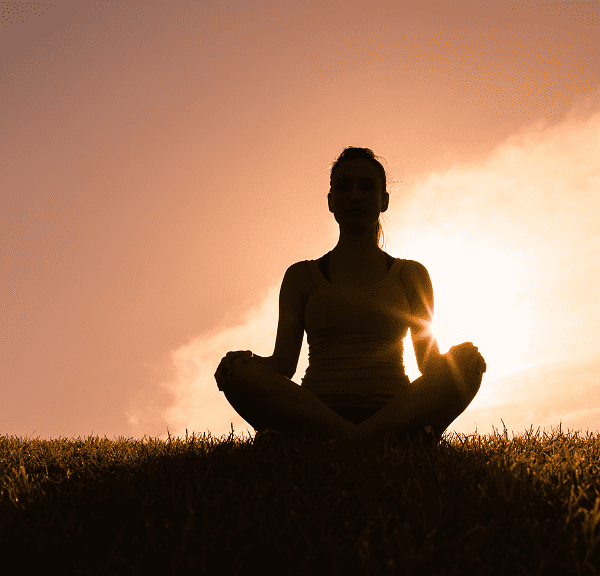
Leave a Reply